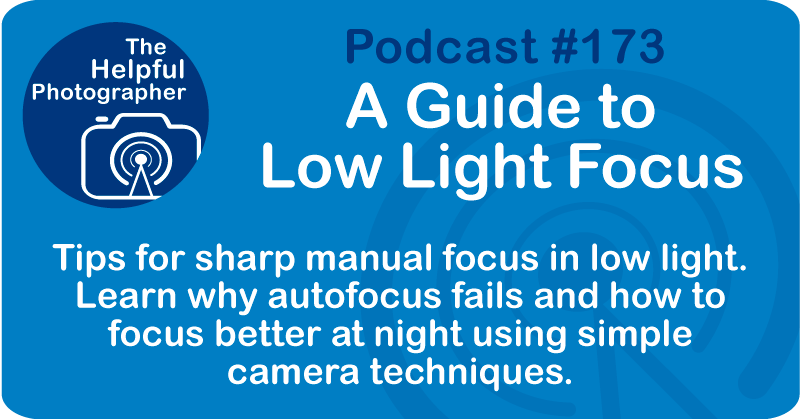A Guide to Low Light Focus #173

Focusing in low light. Yeah, it's something every photographer has struggled with at some point. And that's today's topic — what you can do to help focus in low light. Autofocus these days is pretty amazing. It's fast, it's smart, it's always improving. But even the best autofocus system can completely fall apart when the light gets really low, especially if there's not enough contrast for the camera to lock on to.
So what do you do when your camera just won't focus? Well, the answer is actually pretty simple: you switch to manual focus. I know some of you are groaning already. Manual focus can be tough, especially if your eyesight isn't perfect. And yeah, if you're wearing glasses — folks, please make sure your prescription is up to date and make sure you carry your glasses with you. All right, got that off my chest.
So the other problem with manual focus is when you're in manual focus, your camera will still take the shot even if nothing's actually in focus. But don't worry, I've got a couple of tricks that'll help make manual focus way more usable, even in really dark conditions.
First up, let's talk about your camera. If you're shooting a DSLR, go ahead and flip to live view. If your DSLR doesn't have live view, well, good luck, because I got nothing. For mirrorless shooters, you've got it easier. You can either use the rear screen or your electronic viewfinder. But in really dark situations, I find that the rear screen is usually easier to work with.
Now here's the trick: magnify your screen. And just to be clear, I'm talking about digitally magnifying the image on your LCD — not zooming with your lens. Most cameras have a button or a setting for this. Once you've magnified the image, look for any little bit of contrast — a light source, the edge of a structure, anything that gives you a defined edge. Then, using that magnified view, slowly adjust your focus ring until the edge looks as crisp and sharp as possible. Take your time. This is one of those situations where patience really pays off.
If you're shooting something far away, like the Milky Way or a landscape at night, you might be tempted to just turn your focus ring all the way to the infinity symbol and call it. But here's the thing — on a modern lens, infinity focus isn't usually at the infinity mark. It can shift slightly depending on the lens, the temperature, or even how the lens was manufactured. So yeah, just cranking it to the end won't guarantee a sharp shot. You still have to find focus manually.
Let me give you a real example. I was recently in New Zealand photographing the aurora and the Milky Way over Mount Cook, and guess what? My camera couldn't autofocus on the stars. They just weren't bright enough. So instead, I pointed the camera at Venus, which was the brightest thing in the sky that night. The camera still couldn't autofocus. So I used the magnify feature on my LCD, focused manually until Venus looked razor sharp, and then left the focus ring alone for the rest of the shoot. It worked perfectly.
And just as a reminder: once you're in manual focus, as long as you don't touch the focus ring, your focus will stay locked. That's important, especially when you're working in low light where it's easy to bump things. If you're not shooting at infinity and your scene's still super dark, just widen your search. Look for something in the frame that has a little contrast — maybe a sign with a bit of light on it, the edge of a building, or even someone holding a flashlight — or use a flashlight to light up that object.
Then magnify that spot, dial in your focus, and take a test shot. If it looks a little soft, make a tiny adjustment. If it gets worse, just turn the focus ring in the other direction. Take a shot and check again. Keep doing that until your image is focused. That's it. It's not really rocket science.
Oh wait, I almost forgot. For those who are thinking, "But I have focus assist, why not just use that?" Well, here's the thing — there are a few types of focus assist, like focus peaking or zebra stripes. But if autofocus isn't working, chances are focus assist isn't going to work either. It's not going to give you any zebra stripes. If there's not enough light or contrast for the camera to quote-unquote "see," those tools don't kick in.
So yeah, follow the steps and you'll have a much better shot at nailing it. I hope my tips make manual focus a little less intimidating — and a lot more useful the next time you're out in the dark.











